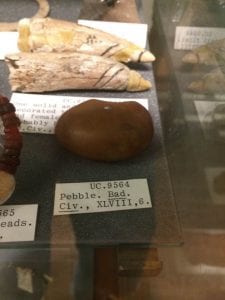Label Detective: what’s a museum without a mystery?
By tcrnkl0, on 12 May 2017
I love — not just the artefacts — but the artefact labels at Petrie Museum of Egyptian Archaeology. Written over a period of seven decades (there are 80,000 artefacts, and they started systematically registering them in 1934), the labels come in a variety of papers, typefaces, tones and are in turns, informative, poetic, confusing, and occasionally troubling. Many of the ones that fall into the the latter two categories are that way because the labels were written for the purposes of expert study and teaching, not public browsing.
Although I spend a lot of time in the Petrie Museum as a Student Engager, I am not an Egyptologist, so often the labels are a mystery to me — and there are some weird ones! Hence my new role.
*Puts on deerstalker hat and wedges a bubble pipe between teeth*
Label Detective – 1st Case
Case Notes: I usually stand in front of the case of glass artefacts during my shift, so I have spent a lot of time considering this squidgy little fellow [centre, in the clear tray]. It looks a Pokémon (Psyduck?!) who has seen better days.
The Label [located behind artefact]:
‘?Provenance UC. 22240
Glass amulet: cynocephalus ape
Late Dyn. XVIII-XIX’
The provenance, or where the artefact came from, is one question already on the label, but I just really want to know what kind of crazy ape it is. So, ‘cynocephalus’ is our five dollar, five-syllable word for the day! From the Greek, the word literally means dog-head, but it also describes a baboon (making baboons dog-headed monkeys). The museum catalog gives us a bit more about the artefact itself: the full figure would have showed its arms resting on its knees, and the nub on its head is a missing loop for hanging it from a string or thong.
The presence of baboons in ancient Egypt is actually a bit of a mystery in itself, because baboons aren’t native to Egypt. They were instead imported to Egypt, in part because of their behaviour. In the mornings, baboons stretch and vocalise in a way that looks like they could be engaging in worship (of the Sun-god Ra). Thoth, the god of writing and wisdom, was also sometimes depicted as a baboon.
Status: Closed. You can see a later example of a faience figure of a baboon from the Met’s website, as well as information about ancient Egyptian amulets.
Case 2: Bad mystery
Case notes: Did Petrie have something against this particular pebble?
I solved this one before I even got away from the cabinet — looking around at artefacts nearby, I deduced that Bad Civ refers to the Badari civilization or Badari culture, which dates back to predynastic Egypt (late Neolithic).
From the museum catalog, we also learn that these pebbles were found in tombs, and mostly identified as tools for grinding cosmetics.
Status: Closed, plus or minus a few pebbles.
Next time on Label Detective: What does a foreigner look like?
Kyle Lee-Crossett is a UCL Student Engager and PhD student at the Institute of Archaeology. Their research is part of the Heritage Futures research programme.
2 Responses to “Label Detective: what’s a museum without a mystery?”
- 1
-
2
Label Detective: Are we alone in here? | UCL Researchers in Museums wrote on 20 September 2017:

[…] the first two instalments of the Label Detective series we investigated the meaning of the word cynocephalus and the impact of British eugenics on Egyptian archaeology. Now we’re moving over to the Grant […]
 Close
Close





[…] Label Detective: what’s a museum without a mystery? […]